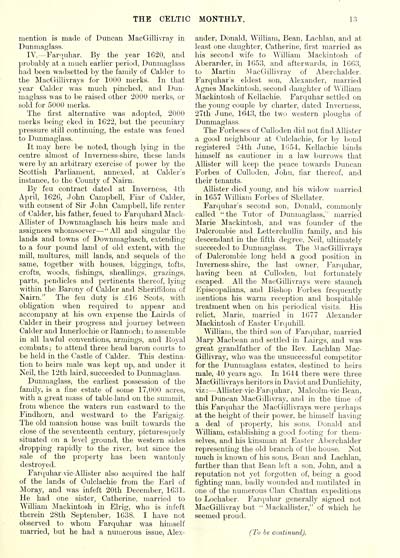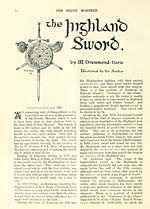Blair Collection > Celtic monthly > Volume 5, 1897
(27)
Download files
Complete book:
Individual page:
Thumbnail gallery: Grid view | List view

THE CELTIC MONTHLY.
l:'.
mention is made of Duncan MacGilli\Tay in
Dunmaglass.
IV. — Parijubar. By the year 1620, and
probably at a jiuich earlier period, Dunmaglass
had lieeu wadsetted by the family of Calder to
the ^llacCiillivrays for 1000 merks. In that
year Calder was much pinched, and Dun-
maglass was to be raised other 2000 merks, or
sold for 5000 merks.
The first alternative was adopted, 2000
merks being eked in 1622, but the pecuniary
jjressure still continuing, the estate was feued
to Dunmaglass.
It may here be noted, though lying in the
centre almost of Inverness-shire, these lands
were by an arbitrary exercise of power by the
Scottish Parliament, annexed, at Calder's
instance, to the County of Nairn.
By feu contract dated at Inverness, 4th
April, 1626, John Campbell, Fiar of Calder,
with consent of Sir John Campbell, life renter
of Calder, his father, feued to Farquhard Mack-
Allister of Downmaglasch his heirs male and
assignees whomsoever — "All and singular the
lauds and towns of Downmaglasch, extending
to a four pound land of old extent, with the
mill, multures, mill lands, and sequels of the
same, together with houses, biggings, tofts,
crofts, woods, fishings, sheallings, grazings,
parts, pendicles and pertinents thereof, lying
within the Barony of Calder and Sherift'dom of
Nairn." The feu duty is .£16 Scots, with
obligation when required to appear and
accompany at his own expense the Lairds of
Calder in their progress and journey between
Calder and Innerlochie or Eannoch ; to assemble
in all lawful conventions, armings, and Royal
combats ; to attend three head baron courts to
be held in the Castle of Calder. This destina-
tion to heirs male was kept up, and under it
Neil, the 12th laird, succeeded to Dunmaglass.
Dunmaglass, the earliest possession of the
family, is a fine estate of some 17,000 acres,
with a great mass of table-land on the summit,
from whence the waters run eastward to the
Findhorn, and westward to the Farigaig.
The old mansion house was built towards the
close of the seventeenth century, picturesquely
situated on a level ground, the western sides
dropping rapidly to the river, but since the
sale of the property has been wantonly
destroyed.
Farquhar-vic-Allister also acquired the half
of the lands of Culclachie from the Earl of
Moray, and was infeft 20th December, 1631.
He had one sister, Catherine, married to
"William ilackintosh in Elrig, who is infeft
therein 28th September, 1638. I have not
observed to whom Farquhai' was himself
married, but he had a numerous issue, Alex-
ander, Donald, William, Bean, Lachlan, and at
least one daughter, Catherine, first married as
his second wife to A\'illiam Mackintosh of
Aberarder, in 1653, and afterwards, in 1663,
to Martin MacGillivray of Aberchalder.
Farquhar's eldest son, Alexander, married
Agnes Mackintosh, second daughter of Wilham
Mackmtosh of Kellachie. Farquhar settled on
the young couple by charter, dated Inverness,
27th June, 1(M3, the two western ploughs of
Dunmaglass.
The Forbeses of Culloden did not find Allister
a good neighbour at Culclachie, for by bond
registered L'ith June, 1654, Kellachie binds
himself as cautioner in a law burrows that
Allister will keep the peace towards Duncan
Forbes of Culloden, John, fiar thereof, and
their tenants.
Allister died young, and his widow married
in 1657 William Forbes of Skellater.
Farquhar's second son, Donald, commonly
called "the Tutor of Dunmaglass,' married
Marie Mackintosh, and was founder of the
Dalcrombie and Letterchullin family, and his
descendant in the fifth degree, Neil, ultimately
succeeded to Dunmaglass. The .MacGillivrays
of Dalcrombie long held a good position in
Inverness- shire, the last owner, Farquhar,
having been at Culloden, but fortunately
escaped. All the MacGillivrays wei'e staunch
Episcopalians, and Bishojj Forbes frequently
mentions his warm reception and hospitable
treatment when on his periodical visits. His
relict, Marie, married in 1677 Alexander
Mackintosh of Easter Ur(|uhill.
William, the third son of Farquhar, married
Mary Macbean and settled in Lairgs, and was
great grandfather of the l\ev. Lachlan JVIac-
Gillivray, who was the unsuccessful competitor
for the Dunmaglass estates, destined to heirs
male, 40 years ago. In 1()44 there were three
MacGillivraj'S heritors in Daviot and Dunlichity,
viz : — Allister-vic-Farquhar, Malcolm-vic-Bean,
and Duncan MacGillivray, and in the time of
this Far(juhar the MacGillivrays were perhaps
at the height of their power, he himself having
a deal of property, his sons, Donald and
WilUam, establishing a good footing for them-
selves, and his kinsman at Easter Aberchalder
representing the old branch of the house. Not
much is known of his sons, Bean and Lachlan,
further than that Bean left a son, John, and a
reputation not yet forgotten of, being a good
fighting man, badly wounded and mutilated in
one of the numerous Clan Chattan expeditions
to Lochaber. Farquhar generally signed not
MacGillivray but " Mackallister," of which he
seemed proud.
('To be coiUmuedJ.
l:'.
mention is made of Duncan MacGilli\Tay in
Dunmaglass.
IV. — Parijubar. By the year 1620, and
probably at a jiuich earlier period, Dunmaglass
had lieeu wadsetted by the family of Calder to
the ^llacCiillivrays for 1000 merks. In that
year Calder was much pinched, and Dun-
maglass was to be raised other 2000 merks, or
sold for 5000 merks.
The first alternative was adopted, 2000
merks being eked in 1622, but the pecuniary
jjressure still continuing, the estate was feued
to Dunmaglass.
It may here be noted, though lying in the
centre almost of Inverness-shire, these lands
were by an arbitrary exercise of power by the
Scottish Parliament, annexed, at Calder's
instance, to the County of Nairn.
By feu contract dated at Inverness, 4th
April, 1626, John Campbell, Fiar of Calder,
with consent of Sir John Campbell, life renter
of Calder, his father, feued to Farquhard Mack-
Allister of Downmaglasch his heirs male and
assignees whomsoever — "All and singular the
lauds and towns of Downmaglasch, extending
to a four pound land of old extent, with the
mill, multures, mill lands, and sequels of the
same, together with houses, biggings, tofts,
crofts, woods, fishings, sheallings, grazings,
parts, pendicles and pertinents thereof, lying
within the Barony of Calder and Sherift'dom of
Nairn." The feu duty is .£16 Scots, with
obligation when required to appear and
accompany at his own expense the Lairds of
Calder in their progress and journey between
Calder and Innerlochie or Eannoch ; to assemble
in all lawful conventions, armings, and Royal
combats ; to attend three head baron courts to
be held in the Castle of Calder. This destina-
tion to heirs male was kept up, and under it
Neil, the 12th laird, succeeded to Dunmaglass.
Dunmaglass, the earliest possession of the
family, is a fine estate of some 17,000 acres,
with a great mass of table-land on the summit,
from whence the waters run eastward to the
Findhorn, and westward to the Farigaig.
The old mansion house was built towards the
close of the seventeenth century, picturesquely
situated on a level ground, the western sides
dropping rapidly to the river, but since the
sale of the property has been wantonly
destroyed.
Farquhar-vic-Allister also acquired the half
of the lands of Culclachie from the Earl of
Moray, and was infeft 20th December, 1631.
He had one sister, Catherine, married to
"William ilackintosh in Elrig, who is infeft
therein 28th September, 1638. I have not
observed to whom Farquhai' was himself
married, but he had a numerous issue, Alex-
ander, Donald, William, Bean, Lachlan, and at
least one daughter, Catherine, first married as
his second wife to A\'illiam Mackintosh of
Aberarder, in 1653, and afterwards, in 1663,
to Martin MacGillivray of Aberchalder.
Farquhar's eldest son, Alexander, married
Agnes Mackintosh, second daughter of Wilham
Mackmtosh of Kellachie. Farquhar settled on
the young couple by charter, dated Inverness,
27th June, 1(M3, the two western ploughs of
Dunmaglass.
The Forbeses of Culloden did not find Allister
a good neighbour at Culclachie, for by bond
registered L'ith June, 1654, Kellachie binds
himself as cautioner in a law burrows that
Allister will keep the peace towards Duncan
Forbes of Culloden, John, fiar thereof, and
their tenants.
Allister died young, and his widow married
in 1657 William Forbes of Skellater.
Farquhar's second son, Donald, commonly
called "the Tutor of Dunmaglass,' married
Marie Mackintosh, and was founder of the
Dalcrombie and Letterchullin family, and his
descendant in the fifth degree, Neil, ultimately
succeeded to Dunmaglass. The .MacGillivrays
of Dalcrombie long held a good position in
Inverness- shire, the last owner, Farquhar,
having been at Culloden, but fortunately
escaped. All the MacGillivrays wei'e staunch
Episcopalians, and Bishojj Forbes frequently
mentions his warm reception and hospitable
treatment when on his periodical visits. His
relict, Marie, married in 1677 Alexander
Mackintosh of Easter Ur(|uhill.
William, the third son of Farquhar, married
Mary Macbean and settled in Lairgs, and was
great grandfather of the l\ev. Lachlan JVIac-
Gillivray, who was the unsuccessful competitor
for the Dunmaglass estates, destined to heirs
male, 40 years ago. In 1()44 there were three
MacGillivraj'S heritors in Daviot and Dunlichity,
viz : — Allister-vic-Farquhar, Malcolm-vic-Bean,
and Duncan MacGillivray, and in the time of
this Far(juhar the MacGillivrays were perhaps
at the height of their power, he himself having
a deal of property, his sons, Donald and
WilUam, establishing a good footing for them-
selves, and his kinsman at Easter Aberchalder
representing the old branch of the house. Not
much is known of his sons, Bean and Lachlan,
further than that Bean left a son, John, and a
reputation not yet forgotten of, being a good
fighting man, badly wounded and mutilated in
one of the numerous Clan Chattan expeditions
to Lochaber. Farquhar generally signed not
MacGillivray but " Mackallister," of which he
seemed proud.
('To be coiUmuedJ.
Set display mode to: Large image | Transcription
Images and transcriptions on this page, including medium image downloads, may be used under the Creative Commons Attribution 4.0 International Licence unless otherwise stated. ![]()
| Early Gaelic Book Collections > Blair Collection > Celtic monthly > Volume 5, 1897 > (27) |
|---|
| Permanent URL | https://digital.nls.uk/75851291 |
|---|
| Shelfmark | Blair.57 |
|---|---|
| Additional NLS resources: | |
| Attribution and copyright: |
|
| Description | A selection of books from a collection of more than 500 titles, mostly on religious and literary topics. Also includes some material dealing with other Celtic languages and societies. Collection created towards the end of the 19th century by Lady Evelyn Stewart Murray. |
|---|
| Description | Selected items from five 'Special and Named Printed Collections'. Includes books in Gaelic and other Celtic languages, works about the Gaels, their languages, literature, culture and history. |
|---|

